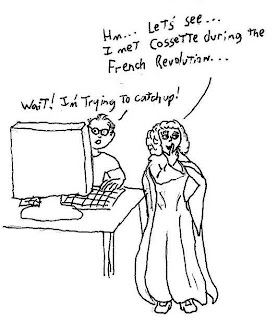Stephenie Meyer woke up after a strange dream about a love struck vampire and a mortal girl in a meadow. She quickly wrote down the dream as best as she could remember. JK Rowling pictured her main character while riding a commuter train and took no time to jot the ideas and concepts down on any paper she could find.
Like them or not, you can’t deny the impact both authors have had on the industry. If either one blew off their flashes of idea, where would their fans be now? Both introduced people to the world of books during an age of TV, video games and other visual forms of entertainment.
Writers have a gift. We have the talent for seeing interesting characters, places and situations where others see only what’s in front of them. Last time I wrote about the effect of music on inspiration but today I’d like to focus on what you should do once that inspiration strikes.
Ideas come from everywhere. A quiet campsite, a bubbling brook, a crowded city, the view from a plane window, a vivid dream, or even other’s creations can all bring ideas. We watch a show or read a book and a thought strikes us: “That’s all well and good but what if…”
If and when these ideas strike there is one thing and only one thing you should do. As quick as possible, before anything or anyone stops you, write it down and keep it. I don’t care if you prefer to write long hand on paper, napkins, flesh or toilet paper. I don’t care if you choose to keep folders of scribbles that only you or a team of trained code breakers could understand. I don’t care if you prefer to keep electronic files full of notes. All that matters is that you write down, record or even video any idea for later.
I personally like a loose outline. Many don’t. In fact the writers’ website known as Absolute Write has that very question in their members profile info. Outline or no outline? Ultimately it matters not as long as you have a system that works.
Here is my system:
1) Idea pops into my head.
2) I use whatever is available to write it down (if nothing is available, I keep the idea in the back of my head until I get something to write it down).
3) Once home I transfer the idea into my notes, i.e. my “Who’s Who” or “Timeline”. Save file.
4) Refer back to notes when I reach that character or scene.
Simple, no?

Let me explain the “Who’s Who” and “Timeline”.
For me, the term “Who’s Who” comes from DC Comics. Back in the ‘80s they published their “Who’s Who” over a twelve month period. Each issue featured their various characters. There was information on their full names, birth dates, death dates, eye & hair color, height & weight, history, powers & abilities and anything else that mattered. Marvel comics did the same thing but called it The Official Handbook of the Marvel Universe.
In my Annabelle’s Who’s Who, I don’t go into all that detail unless that stuff is worked out. I do include any information that is important to my stories. This might be their history, motivations, relationships or passions. When an idea for a new character or changes to an existing character strikes me I open the file and put it in.
My Timeline is a list of every major event in the lives of Annabelle and Roland from 1687 AD to the current time.
I’m writing a YA historical vampire fantasy fiction series. One of the reasons I placed Ann’s origins three-hundred years in the past was to have fun with history. As far as I can tell, every vampire story begins with a human from now-a-days meeting a vampire. The vamp isn’t the MC because we can’t relate with someone who lived forever. I beg to differ. Sure, I could be wrong but why not go with the dream?
So instead of beginning now and have my vamps say “Remember when the Salem jail was packed with dirty innocent people and we had to rescue that real witch?” I show them doing events in order of when they actually experience them. So the famous witch trails are touched upon in the first book, pirates and post-fire London in the second, and so on.
With this plan, I need a comprehensive list of where they were during the last three-hundred years. When a character or setting pops into my head, I add it to my Timeline. When I come across a particularly juicy piece of history, I put it in my Timeline.
When I actually write the stories, I copy and paste the notes needed into my actual story, then write through as the inspiration takes me, including the notes where they fit into the story.
This system works for me. What systems do you use to catch inspiration and bottle it up until you need it?
2 comments:
Not that far from what I do, really. I use the notepad on my smartphone to record most of my ideas. Recently I've been writing scenes out of order as I feel like it and then adding transitions later. I used to only write chronologically, but this is working better. I guess it's an evolving process.
Great post, Jack!
~Tara
Sure is! Thanks!
Post a Comment